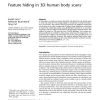Free Online Productivity Tools
i2Speak
i2Symbol
i2OCR
iTex2Img
iWeb2Print
iWeb2Shot
i2Type
iPdf2Split
iPdf2Merge
i2Bopomofo
i2Arabic
i2Style
i2Image
i2PDF
iLatex2Rtf
Sci2ools
IVS
2006
2006
Feature hiding in 3D human body scans
In this paper, we explore a privacy algorithm that detects human private parts in a 3D scan data set. The analogia graph is introduced to study the proportion of structures. The intrinsic human proportions are applied to reduce the search space in an order of magnitude. A feature shape template is constructed to match the model data points using Radial Basis Functions in a non-linear regression and the relative measurements of the height and area factors. The method is tested on 100 data sets from CAESAR database. Two surface rendering methods are studied for data privacy: blurring and transparency. It is found that test subjects normally prefer to have the most possible privacy in both rendering methods. However, the subjects adjusted their privacy measurement to a certain degree as they were informed of the context of security. Information Visualization (2006) 5, 271--278. doi:10.1057/palgrave.ivs.9500136
| Added | 13 Dec 2010 |
| Updated | 13 Dec 2010 |
| Type | Journal |
| Year | 2006 |
| Where | IVS |
| Authors | Joseph Laws, Nathaniel Bauernfeind, Yang Cai 0002 |
Comments (0)

